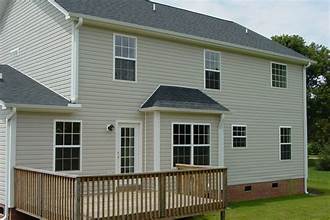Missing siding on a house can pose significant challenges and issues for homeowners. From potential structural damage to decreased energy efficiency, the absence of siding can have far-reaching consequences. This article delves into the various aspects of missing siding, offering insights and solutions to help you navigate this common problem with ease.
Before we explore the different facets of missing siding, it's essential to understand the signs, causes, consequences, and repair options associated with this issue. By the end of this read, you'll be equipped with valuable knowledge to tackle missing siding effectively.
How to Identify Missing Siding on a House
Identifying missing siding on a house is crucial to maintaining the integrity and appearance of the property. Here are some common signs to look out for:Common Signs of Missing Siding
- Visible gaps or holes in the siding
- Warped or buckled siding panels
- Peeling paint or wallpaper inside the house
- Increased energy bills due to poor insulation
Impact of Missing Siding on the House
- Exposure to the elements can lead to water damage and mold growth
- Decreased energy efficiency and higher utility costs
- Aesthetically unpleasing appearance of the house
Areas Where Siding is Often Missing
- Around windows and doors
- Near the roofline and eaves
- Along the foundation of the house
Causes of Missing Siding
Missing siding on a house can be attributed to various factors, ranging from environmental conditions to poor installation practices. Understanding these causes is crucial in addressing and preventing the issue effectively.Environmental Factors
- Harsh Weather Conditions: Extreme weather such as strong winds, heavy rain, hail, or snow can damage siding and cause it to detach or go missing.
- UV Exposure: Prolonged exposure to sunlight can weaken siding materials over time, making them more susceptible to damage and detachment.
- Moisture and Humidity: Moisture infiltration due to improper drainage or high humidity levels can lead to rotting of siding, causing it to fall off.
Poor Installation Practices
- Inadequate Fastening: Improper fastening of siding during installation can result in loose panels that are prone to falling off or getting blown away by strong winds.
- Incorrect Material Selection: Choosing the wrong type of siding for the specific climate or not following manufacturer guidelines can lead to premature deterioration and missing siding.
- Lack of Maintenance: Neglecting regular maintenance tasks such as cleaning, painting, or repairing damaged sections can contribute to the deterioration and eventual loss of siding.
Consequences of Ignoring Missing Siding
Ignoring missing siding on a house can lead to various negative consequences that can impact the structural integrity, energy efficiency, and overall curb appeal of the property.Potential Structural Damage
- Water infiltration: Missing siding can allow water to seep into the walls, leading to rot, mold, and deterioration of the underlying structure.
- Pest infestation: Gaps in the siding can provide easy access for pests like termites and carpenter ants, causing damage to the wooden framework of the house.
- Foundation issues: Without proper protection from siding, the foundation of the house may be exposed to moisture, leading to cracks and other structural problems.
Impact on Energy Efficiency
- Increased energy bills: Gaps in the siding can result in heat loss during winter and heat gain during summer, forcing the HVAC system to work harder and increasing energy consumption.
- Poor insulation: Missing siding can compromise the insulation of the house, making it harder to maintain a comfortable indoor temperature throughout the year.
- Drafts and air leaks: Holes in the siding can allow drafts and air leaks, reducing the overall energy efficiency of the house and creating discomfort for occupants.
Affect on Curb Appeal
- Deterioration of appearance: Missing siding can make the house look unkempt, aged, and in need of repair, diminishing its overall curb appeal.
- Decreased property value: A house with missing siding may appear neglected and unattractive to potential buyers, leading to a decrease in property value.
- Negative first impression: The exterior of a house with missing siding can create a negative first impression on visitors and passersby, affecting the overall perception of the property.
Repairing Missing Siding
When it comes to repairing missing siding on a house, there are a few important steps to follow to ensure a proper fix. It's crucial to address any missing siding promptly to prevent further damage to the structure of the house.Steps for Repairing Missing Siding
- Inspect the area: Begin by examining the extent of the damage and identify any underlying issues that may have caused the siding to go missing.
- Remove the damaged siding: Carefully take out any remaining pieces of siding that are damaged or missing completely.
- Clean the area: Make sure the surface is clean and free of debris before proceeding with the repair.
- Replace the siding: Install new siding that matches the existing material to ensure a seamless look.
- Secure the siding: Use appropriate nails or screws to secure the new siding in place, making sure it is properly aligned with the rest of the house.
- Paint or finish: If needed, paint or finish the new siding to match the color and texture of the existing siding.
Importance of Matching Existing Siding Materials
It is essential to match the existing siding materials when repairing missing siding on a house to maintain the overall aesthetic appeal and integrity of the property. Mismatched siding can stand out and detract from the curb appeal of the home.Tips for DIY Siding Repairs versus Hiring Professionals
- DIY repairs: If you have experience with home repairs and feel confident in your abilities, DIY siding repairs can be a cost-effective option. Make sure to follow proper safety precautions and use the right tools for the job.
- Hiring professionals: For more complex siding issues or if you are unsure about the repair process, hiring professionals is recommended. They have the expertise and equipment to handle the repair efficiently and effectively.
- Consider the scope of the repair: Before deciding whether to DIY or hire a professional, consider the extent of the damage and your comfort level with the repair process.

